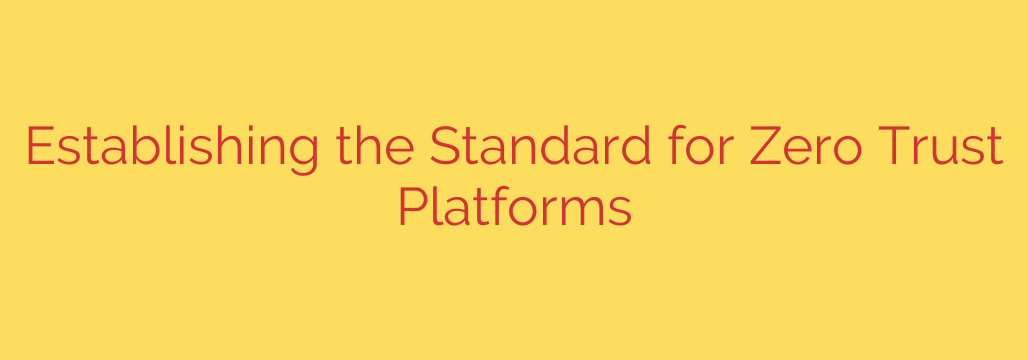
Building a Foundation: Establishing the Standard for Modern Zero Trust Security
In today’s complex digital landscape, traditional perimeter-based security models are increasingly obsolete. The move towards cloud computing, remote workforces, and interconnected ecosystems means the “network edge” has dissolved. This shift mandates a new approach: Zero Trust.
Zero Trust fundamentally means never trust, always verify. It requires strict identity verification for every person and device trying to access resources on a private network, regardless of whether they are inside or outside the network perimeter. While the principle is clear, implementing Zero Trust effectively across diverse environments remains a significant challenge for many organizations.
The current reality often involves deploying a collection of disparate security tools, each addressing a specific Zero Trust component (like identity management, endpoint security, microsegmentation, or threat detection). While these individual tools are valuable, a fractured approach creates complexity, visibility gaps, and operational overhead. What is needed is a more cohesive, platform-centric standard for building and maintaining Zero Trust security.
A truly effective Zero Trust platform should unify and integrate critical security functions, providing a comprehensive view and centralized control. Key elements that define a robust platform standard include:
- Strong Identity Governance: At the core of Zero Trust is verifying who or what is requesting access. A standard platform must provide robust identity and access management (IAM), including multi-factor authentication (MFA), adaptive access policies based on context (user, device, location, behavior), and continuous authorization checking.
- Device Security and Posture Management: Access decisions aren’t just about the user’s identity; they’re also about the health and security posture of the device being used. A platform should continuously assess devices (laptops, mobile phones, IoT) for compliance, patches, configurations, and malware presence before granting or maintaining access.
- Workload and Application Security: Protecting applications and workloads (whether in the cloud, on-premises, or containerized) is crucial. This involves segmentation at a granular level (microsegmentation) and applying policies based on workload identity rather than network location.
- Data Protection: Security ultimately aims to protect data. A Zero Trust platform standard should incorporate data classification, loss prevention (DLP), and policies that enforce data access controls based on user identity and context, encrypting data at rest and in transit.
- Network and Environment Security: While Zero Trust moves beyond the perimeter, securing network flows and environments remains vital. This includes secure connectivity, threat prevention, and visibility into all communication paths.
- Visibility, Analytics, and Automation: You can’t protect what you can’t see. A standardized platform must offer deep visibility across users, devices, applications, and data flows. Crucially, it needs powerful analytics to detect anomalies and threats, coupled with automation to enforce policies, isolate threats, and respond rapidly without manual intervention.
- Orchestration and Policy Management: Managing complex security policies across diverse environments is simplified through centralized orchestration. A platform standard ensures that policies are defined once and consistently applied across all access points and resources.
Actionable Advice for Adopting a Platform Standard:
- Prioritize identity as the primary control plane.
- Seek integrated solutions that reduce complexity and improve visibility.
- Focus on automation to scale security operations.
- Implement continuous monitoring and verification for all access.
- Ensure the platform supports your diverse infrastructure (cloud, on-prem, hybrid).
Moving towards a standardized, platform-based approach to Zero Trust is not just about implementing new technology; it’s about transforming security architecture and operations. By integrating key security functions and enforcing unified policies based on verified identities and device posture, organizations can build a more resilient defense against modern cyber threats and confidently enable secure access for their dynamic workforce and evolving infrastructure. Establishing clear standards for these platforms is essential for achieving the full promise of Zero Trust security.
Source: https://www.paloaltonetworks.com/blog/2025/07/setting-standard-zero-trust-platforms/








